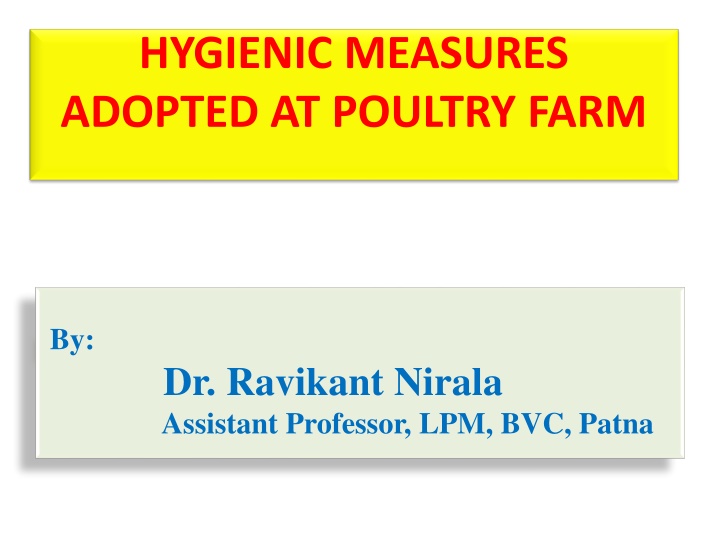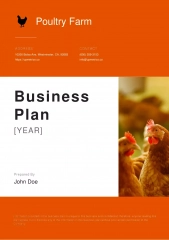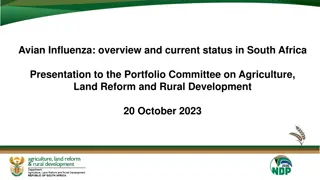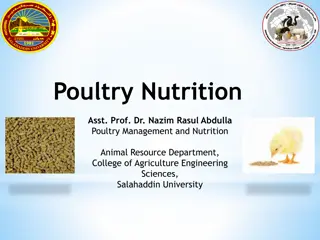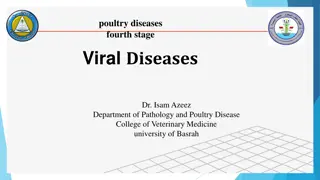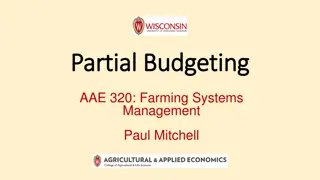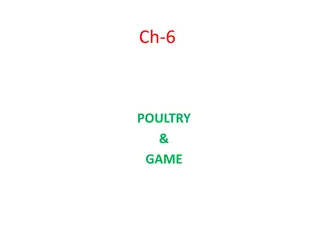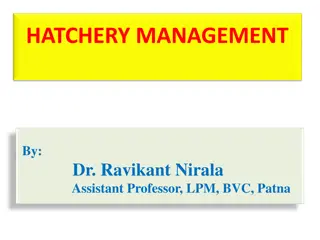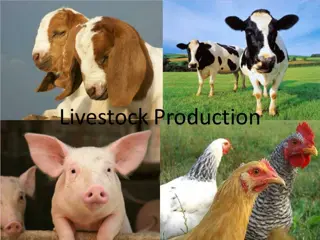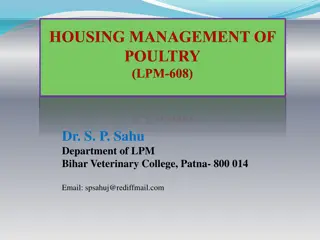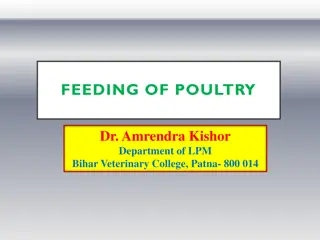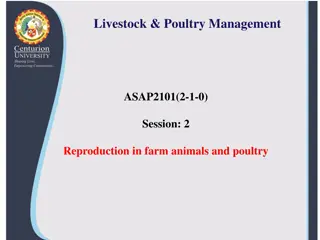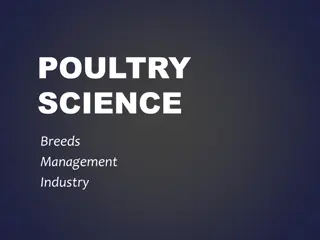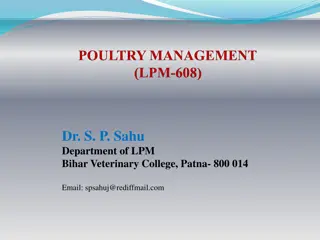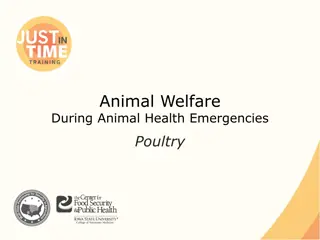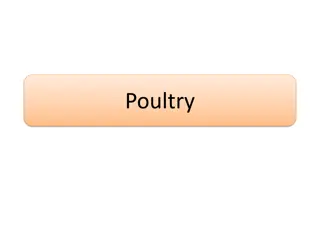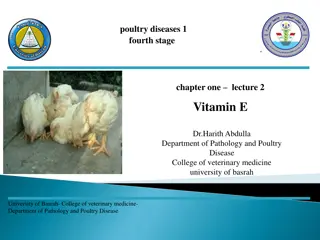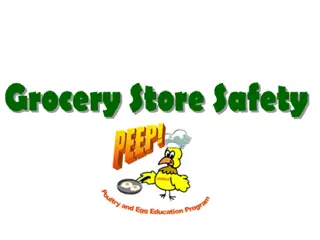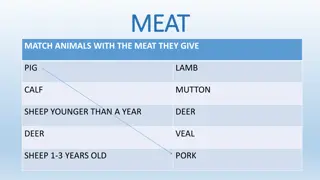Hygienic Measures for Poultry Farm Management
Poultry waste management, farm hygiene, sanitation, and environmental issues are critical for maintaining a healthy poultry farm. Disinfection, while important, is not a substitute for cleanliness. Effective disinfectants should have good germicidal activity, be non-toxic to humans and birds, work on uncleaned surfaces, non-corrosive, and cost-effective. Formaldehyde fumigation and hydrogen peroxide are common methods used for disinfection in poultry houses. Proper selection and application of disinfectants are essential for effective farm hygiene.
Download Presentation

Please find below an Image/Link to download the presentation.
The content on the website is provided AS IS for your information and personal use only. It may not be sold, licensed, or shared on other websites without obtaining consent from the author.If you encounter any issues during the download, it is possible that the publisher has removed the file from their server.
You are allowed to download the files provided on this website for personal or commercial use, subject to the condition that they are used lawfully. All files are the property of their respective owners.
The content on the website is provided AS IS for your information and personal use only. It may not be sold, licensed, or shared on other websites without obtaining consent from the author.
E N D
Presentation Transcript
HYGIENIC MEASURES ADOPTED AT POULTRY FARM By: Dr. Ravikant Nirala Assistant Professor, LPM, BVC, Patna
Poultry waste management, Farm Hygiene, Sanitation and environmental issues Disinfection is not a substitute for cleanliness. It is one of the ways to destroy organism and it can best be done in the absence of foreign organic matters. When one considers the attributes of the various disinfectants available to the consumers, it becomes obvious that no one is adequate for all the conditions. Properties of some common disinfectants are given below : Good germicidal activity Non-toxic to both man and birds Effective on uncleaned surface Non-corroding and non-staining the surfaces Should have wetting property Divided of odour Ready availability Economical
Antisepsis living tissue. For the purpose of inhibiting or destroying micro-organisms. Selection of agents for disinfection of poultry houses Formaldehyde fumigation: Formaldehyde is used in poultry industry over decades but the concentration and use is not up to expectation. Formaldehyde is commercially available as a 40% solution in water (37% by weight) known as formalin, and as a powder, para-formaldehyde, containing 91% formaldehyde. When either is heated, formaldehyde gas is liberated. Human skin is very sensitive to formalin and there should be no direct contact. The following are the minimum requirements for effective fumigation of hatchers/setters. 1) 5 ml of Formalin & 1.0 g of Potassium permanganate / cubic foot of incubator space (with eggs) 2) 25 ml of Formalin and 1.5 g of potassium permanganate / cubic foot of incubator space (empty incubator). Continuous fumigation of setters, ten percent formalin (1- ml of formalin made up100 ml) is placed in a shallow tray 6 diameter and a layer of 3 mm is maintained by periodical addition. An antiseptic is defined as a germicide that is used on skin or
Continuous fumigation of hatchers. 40 per cent formalin (40 ml Formalin made up to 100 ml) is placed in a shallow tray 12 diameter and a layer of 3-4 mm is maintained by periodical addition. Don t fumigate eggs during incubation 24-96 hours. The temperature should be more than 20oC. The humidity should be 80-90%. The ratio of fumigants i.e. formalin and potassium permanganate should be 3:2 Hydrogen peroxide H2O2 Hydrogen peroxide has been used successfully for many years as a disinfectant, particularly as decontaminant over surface and as a sterilant in industrial and commercial programmes. The advantages of hydrogen peroxide over formaldehyde are : No unpleasant odour, Not toxic, Minimal safety problem for workers
The use of hydrogen peroxides in poultry industry Commercial hydrogen peroxide is available at 50% concentration. H2O2-5% (1 part of 50% H2O2and 9 parts of water) can be used for decontamination of hatching eggs. Immediately after collection, the eggs are sprayed with 5% H2O2and it essential to maintain the temperature of the spray at 42o C to 45oC. 3% H2O2can be used as a spray for shelters and hatchers with eggs. 2 ml of 50% H2O2for every 100 litre of water can be used as sanitizer. 50% H2O2can be used as a spray for decontamination of moulds in hatcheries and farm premises. Per acetic acid (PAA) Peracetic acid is a colourless liquid miscible with water and organic solvents. Peracetic acid is more active than H2O2against bacteria and spores. The breakdown product are non toxic viz. acetic acid and oxygen. Stainless steel, glass and plastics are resistant. Peracetic acid is not available commercially. The peracetic acid can be prepared easily. Commercial acetic acid 98% Commercial Sulphuric acid 98% Commercial Hydrogen peroxide 50% Mix it in a polythene container and allow to ripen for 6-12 hours. The resulting per acetic acid concentration is about 35%. - 1 ltr. - 11 ml. - 2 ltr.
Uses of per acetic acid 0.1-2% concentration for decontamination of surfaces, floor, walls &litter. Chlorine dioxide : The basic requirements of a drinking water sanitizer are : Odorless/tasteless, Safe, Removes bio-films, No harmful residue The answer for all these requisites is chlorine dioxide. In all developed countries, chlorine dioxide has replaced chlorine in water sanitizing programmes. The only drawback with chlorine dioxide is that it has to be generated at situ. Gluteraldehyde A 2% commercial gluteraldehyde is a satisfactory sporocidal agent and it can be used as chemo-sterilant. The only drawback of gluteraldehyde is the cost and long contact time. Synergistic chemo-sterilant In recent years, lower concentration of H2O2and PAA are used as chemo- sterilants. The working decontaminate is prepared as follows. Peracetic acid 35% - 3 ml Hydrogen peroxide 50% - 20 ml Water This is known as 1x upto 5x concentration can be prepared by increasing the concentration of PAA and H2O2. PAA and H2O2combination can be used as a spray for floor, wall, environment, litter, hatchery. More than 1x concentration is used based on level of contamination over inanimate objects. - 1 ltr.
Sanitary Environments: Sanitation may be defined as the means and measures directed toward establishing and maintaining an environment in which it is safe for animals to exist (Ilinshaw, 1966). The micro-organisms although survive for period in the environment they are likely to change their virulence and survivability for long time in an adverse situation and become highly pathogenic and establish themselves in the farm premises. The above chemo-sterilants are approved by international agencies such as EPA, FDA and OIE. Points should be considered while Fumigation with formaldehyde gas. 1. Eggs must be on plastic trays 2. The chamber must be gas tight 3. The correct quantities of gas must be produced for the correct time Key factors in using washing machine are: a. Temperature and b. Concentration of disinfectant solution and c. Maintenance of the machine.
Properties of an ideal disinfectant 1. Low cost per units of disinfecting value 2. Ready solubility in hard water 3. Relative safety for humans and animals 4. Ready availability 5. Non destructive to utensils and fabrics 6. Stability when exposed to air 7. Absence of objectionable odour 8. No residual toxicity 9. It should have a broad spectrum of activity 10. No deleterious accumulation of any portion of the disinfectant in meat or eggs 11. As far as possible it should not posses residual action after use.
These are chemo-sterilants and commercial disinfectants can not compare with these agents. The cost of these chemosterilents are about 1/10 of the commercial disinfectants. These are potent replacers of formalin which is suspected as carcinogen. Sources and route of infection: Human Neighbour work crews Visitors Recovered carrier Multiple age Started pallets Poultry show stock Mixed species of Poultry Ventilation/air Equipments Feed and Water Birds Insects and pests Eggs Forced moulted hens Contract Breeding stock Rodents Stray
Growing concentration of egg production unit s results in the production of poultry waste on a large scale. This also poses problems of handling and disposal for many poultry producers, with the public becoming more aware and concerned about environmental pollution. Two main types of wastes are produced by poultry enterprises depending on the rearing system adopted on the farm: poultry litter and cage layer waste. Poultry litter is the waste from deep litter systems and does not have much nutritive value, since it contains mostly used litter material. Cage layer waste consists mainly of excreta collected under the cages, spilled feed and feathers. The use of poultry waste as a source of manure for crop production has been the preferred system for recycling nutrients. In recent years, poultry nutritionists have explored the possibility of recycling poultry waste as a feed for the poultry itself. The use of poultry waste as a source of manure for crop production has been the preferred system for recycling nutrients. Poultry droppings, until now considered as waste, or used sparingly as manure, may prove to be an alternative for conventional feed ingredients. Poultry excreta are commonly referred to as dried poultry droppings, cage layer excreta, dried poultry waste or dried poultry manure. Dried poultry waste reportedly contains about 30 per cent protein, of which about 60 per cent is from non-protein nitrogenous sources. It has more mineral value. Poultry waste has a high water content and there is a need to develop suitable and economical processing technology to remove excessive moisture and destroy harmful pathogens from the organic waste. It is high in fibre and low in metabolizable energy.
It has more mineral value. Poultry waste has a high water content and there is a need to develop suitable and economical processing technology to remove excessive moisture and destroy harmful pathogens from the organic waste. It is high in fibre and low in metabolizable energy. The true digestibility coefficient of crude protein in poultry litter is about 64 per cent. Some of the constituent amino acids were found to range from 24.7 per cent (for valine) to 76.4 per cent (for serine). The absorption of calcium and phosphorus was characteristic of the individual bird and ranged from 1.2-45.3 per cent for calcium and from 7.5-46.2 per cent for phosphorus. Drying the manure with heat has also been attempted. The manure may be dried at temperatures ranging from 149-385oC. Drying with heat results in a highly significant loss of energy and significant loss of nitrogen. Thin bed drying of poultry manure to 30 per cent or lower moisture levels was found to prevent the breeding of flies, to reduce obnoxious odours and to maintain the nutrient value of the manure particles. The faster the manure is dried, the higher is the nitrogen value.
Common pathogens in poultry IBV NDV Pox Fungal spores Haemophillus AEV Coccidia Spirochetes Mycoplansma Fungi Pasteurella IBDV Bacterialspores campylobecter MDV Parasitic Oocytes
Egg Shell Borne Diseases: Several procedures ate used to overcome shell contamination that arises from intestinal contents and other environmental sources. Clean hatching eggs Fumigation of eggs Washing and liquid sterilization Storage facilities Water sanitation : Generally sodium hypochlorite or calcium hypochlorite is use at the level or 5-10 ppm for water sanitization. Disinfection : Several types of disinfectants and sanitizers are available to poultry industry. Each one has an optimum environment in which it is most effective. The pH, compatibility with other comical agents used, amount of organic material present, temperature and humidity must be considered. Methods of disinfection : These fall into two categories: a. Dry cleaning followed by fumigation and b. Washing, dipping or sanitizing.
